If you want to know about the “Snake Plant Brown Tips” It is even if it is healthy the other day when you checked it before that let me tell you snake plant is one of the rigorous and toughest houseplant. Still Sansevieria trifasciata is normal to get leaf problems. There are several reasons which are responsible of Snake Plant Brown Tips, below we will discuss signs ,how to prevent it from happening.
Snake Plant Brown Tips
Snake Plant Brown Tips is due to excessive sunlight or hot climate, underwatering, wrong transplanting, Bad Soil, No draining and more. The Signs on leaf edges starting to get brown or slight red. To fix this Snake Plant Brown Tips problem change the location and put this plant in partial shade where it doesn’t get more than 3 hours of direct light.
Second reason causing Snake Plant Brown Tips is because of the heat I told you above but when there is too much sunlight, then your snake plant needs water to recover water loss. But if the soil gets dry it doesn’t have water in it which results in Snake Plant Brown Tips. Solution to this is to hide the top soil with something like mulch or use grass. I know brown tips and how it happened in the first place.
There was a time when some construction work was going on in my house and I had over 20 Sansevieria trifasciata and I was thinking where to place them. I put some of them in Hard heated Sunlight, with that I put garden soil above them which has some weeds/grass growing. I know that I need to protect the snake plant from losing water so I just topped it with that soil.
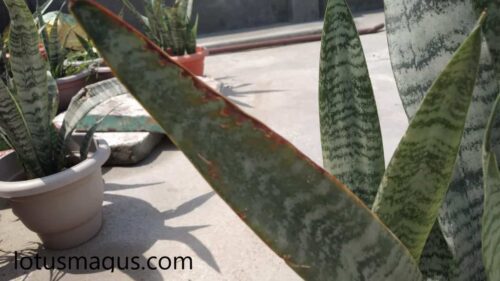
BEST SOIL FOR SNAKE PLANTS – PERFECT PLANTS Black Coral Potting Mix.
In 10 days time, My snake plants are healthy and growing in direct sunlight successfully. But Some of the plants which don’t have cover on the top soil just showed symptoms like Snake Plant Brown Tips. To recover those plants there is no way to turn those leaves into green again.
Also Read – Snake Plant Flower Meaning?

You just have to cut the infected leaf part or the whole leaf. Mostly if this problem occurs, it’s because of sun or water loss.
the 2nd reason people call it inconsistent water or No watering done whenever needed by plants.
People get confused with brown tips and brown spots, I just wanted to tell you these are 2 different problems and for brown spots it happens because of multiple reasons and even disease plays a role in it or pest infection also.
To Make Sure Snake Plant Gets All Nutrients – Buy Perfect Plants Liquid Fertilizer for Snake plants.
Snake Plant Brown Spots
The Common reason for Snake Plant Brown Spots is Improper watering or Contaminated water. There are other climatic reasons, Humidity, Excess dosage of Fertilizer use, Fungal disease or Winter Problem. Brown spots are small or large leaf spots that make plants look diseased, unattractive and unappealing. Snake plants thrive easily but sometimes are stuck in environmental or man made problems, & If you don’t care properly it will only increase the issue.
So I have been reading many forums and most people say they have a perfect water cycle and they keep the soil moist and not totally soggy.
Also Read – Snake Plant Spiritual Meaning?
Most of the time it is an overwatered issue and people don’t even realise it and your snake plant may have a root rot problem that is one sign.
And Some even say that it was perfectly growing for months when they purchased it but after 8 month or a year it started to show brown spots.
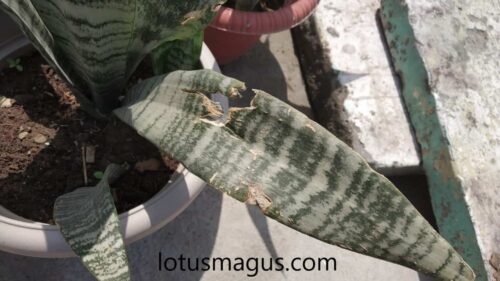
Ok In this case you didn’t even repotted it for so long, don’t this plant need fresh soil that should be fertile and have nutrients. Potting Soil sometimes gets stiff and hard and it doesn’t drain water properly. For that you have to add and mix fresh soil in it and even change the pot size if you have a large pot or vice versa if you have a small pot.
Sansevieria plants don’t require much water in winters so be careful and calculate your watering schedule. Winters is the time you have to check if it needs water and other caring needs like light. Or this may have been freezing in your city climate.
“The Best Solution is just cut down the leaf that has brown spots.” Why I am saying this because these spots can spread to other leaf sections easily and can further damage your plants.
Although This Plant is So tough and rigorous, It will Come back and grow So don’t hesitate while cutting the leaves.
The Way to Make them grow faster is putting them in a Sunlight area where it can get morning sun for around 8am to 12pm after that it doesn’t need sunlight. With Direct Sunlight you have to be careful as it needs water regularly.
To AVOID OVERWATERING – Buy Cylinder Ceramic Planters Specially Made for Snake Plants.
the brown spots are very similar problem just like Snake Plant Brown Tips and solution is also simple to follow.
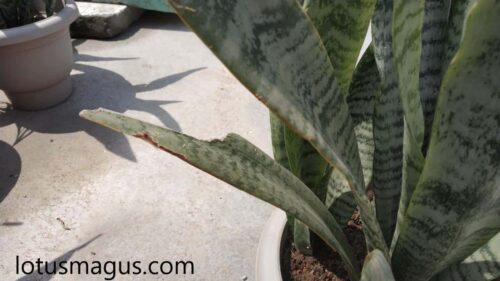
Can I cut the brown tips off my snake plant?
Yes you can trim off the brown tips from the snake plant as this damaged leaf won’t grow and only take space and look ugly so better remove it. One other Solution would be Slice off the total leaf as it will be only taking nutrients so Cutting them will send a signal to rhizome and it will start making another shoot which will grow a new leaf again. New leaves always look good & healthier than older one.
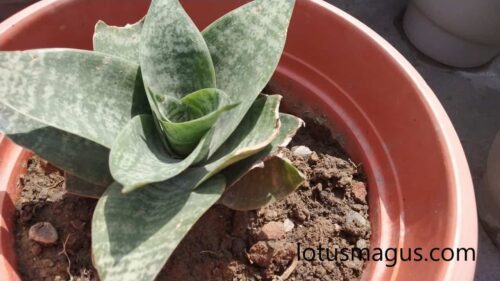
Can you cut brown tips off plants?
Yes you can either cut the brown tip off from the plants or just trim from bottom the whole leaf. Make sure to clean the trimming tool and then trim it. Better to care for the plant and prevent the Brown tips from happening by controlling the watering sessions.
Also Read : Snake Plant Leaves Curling – Fixing Every Problem(Full Guide)
Snake Plant Damaged Leaves
If your snake plant leaves are damaged by your pets or kids while playing or running. It’s very natural to see sansevieria leaves cut from the edges or sides, even curled up or fall down.
So what to do if your leaves curl, have cuts looking unnatural and break down in half or fall down. In this case use a rubbing alcohol to clean the pruner and just cut down the whole leaf and make space for another leaf.
The Snake plant is strong and if any leaf gets hurt, spoiled or wounded or damaged it is not going to grow back but if you remove that whole leaf then Snake plant will start to make another leaf in place of the previous one this way there is no nutrients loss of soil by damaged leaves.
the damaged leaves can happen due toe Snake Plant Brown Tips, overwatering, underwatering, temperature stress and so on.
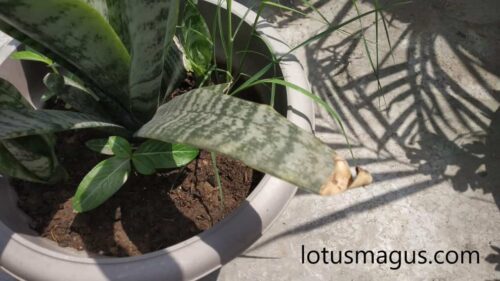
Related Questions about Snake Plant Brown Tips
Brown spots on snake plant
Brown spots on a snake plant can be caused by several factors such as improper watering, too much direct sunlight, pests, fungal problems, plant injury. Sunlight may burn and brown snake plant leaves. To avoid additional harm, place the plant into shade.
Sunlight, fungal infections, pests, stress, and incorrect watering may create snake plant brown patches. Sunlight may burn and brown snake plant leaves. To avoid additional harm, place the plant into shade.
Fungicides or plant removal may cure snake plant brown patches caused by fungus. Insecticides are needed to kill spider mites, mealybugs, and scale insects that create brown stains on snake plant leaves.
Dropping or cutting the snake plant too near to the stem might create brown patches on the leaves. Handling the plant carefully prevents injury.
Poor watering might also create snake plant brown patches. Underwatering may dry up the leaves, while overwatering can produce root rot and brown blotches on the foliage. When the topsoil is dry, water the snake plant.
In conclusion, brown patches on snake plants may be produced by numerous circumstances. It is vital to determine the source and take appropriate action.
the brown spots are very similar problem just like Snake Plant Brown Tips and solution is also simple to follow.
Snake plant leaves brown edges
Brown edges on snake plant leaves can be caused by several factors, including overwatering or underwatering, excess moisture loss from the leaves, or the plant being thirsty.
Brown snake plant leaf edges are often caused by overwatering. Root rot and dark, mushy leaves result from waterlogging and oxygen deprivation in saturated soil. Avoid overwatering by letting the soil dry out between waterings.
Underwatering also browns snake plant leaves. When soil is overly dry, leaves lose moisture faster than roots can absorb it, resulting in brown edges and wilting. Water the plant often to prevent underwatering.
Snake plant leaves may also brown from excessive moisture loss. Low humidity, dry air, or direct sunshine might cause this. To fix this, add a humidifier near the plant or spray the leaves regularly. Move the plant to a shadier spot or use a translucent drape to decrease moisture loss.
Lastly, thirsty snake plants may have brown leaf margins. If the plant outgrows its container or the earth is compacted, this might happen. Consider repotting the plant into a bigger container with new, well-draining soil. To conserve moisture and avoid harm, cover the soil with mulch or stones.
the brown edges are very similar problem just like Snake Plant Brown Tips and solution is also simple to follow.
Care About Snake Plant Brown Tips
Snake plant or Mother in law Tongue is an excellent and perennial succulent that keeps thriving and I personally never see these plants lose hope of growing. Lets Move to Caring Aspects.
Water requirement
Sansevieria is succulent so they generally don’t require a load of water but minimum water to just drink and grow. Its leaves are the one that stores the maximum water, that’s why if you put them in direct sun the first thing that gets dry is its leaves which eventually makes the whole plant lose water.
Watering in a snake plant can be done once or twice a week according to the location or climate. Some people live in rainfall areas , some may have homes outside in the desert and some have too hot summers most in the calendar months.
Most important to remember is when to water snake plants and the answer is whenever it feels thirsty, touch the top soil and see if it’s dry, then pour some water.
Light requirement
Snake plants like to live in shade to partial shade areas, as they don’t want to hurt their leaves with excess sunlight So bright indirect light is all they want.
In my experience, you should put snake plants once a week in direct sunlight or daily in 8-12am direct sunlight as they will grow much quicker and have robust leaves and rhizomes otherwise it takes more to actually make those sneaky leaves.
If you put them in an area which gets only 9-12 light then you should also be watering everyday or in 2 days. But One thing is clear that it will grow at a faster rate than indoors.
Soil requirement
For snake plants, soil should not be any problem as this plant is comfortable in many soil, it can even grow in your backyard soil but if this doesn’t get good drainage then it will root rot easily. That’s why people prefer to use potting mix that comes with everything like nutrients, free from uneven grassy weeds, well draining mix.
Also you should change your soil every 12 months as the older it gets the weaker its nutrients level is.
Change the pot also if you think your snake plant passed the growth and it does not have too many leaves.
Nowadays I am using specially made soil for snake plant, it’s cheap and effective.
here the link you want to buy – Rio Soil Mixture
Also You can use cactus and succulent mix potting soil.
Propagation
The Best thing about Sansevieria is , it keeps popping small baby pups that you can take out and make a new snake plant. These plants are so flexible that you can propagate it from its leaves, rhizomes, half cutted leaves. That’s why I say it never dies and keeps growing more and more with every passing day.
Snake Plant Leaves Bending – Folding, Dropping Down(All Fix)
Toxicity
It is toxic to dogs, cats according to the ASPCA.
It is poisonous but with low severity according to NC State University.
According to University of California, Snake plant has been added to toxicity class 2 and 4; minor toxicity with dermatitis means skin problems.
All the references provided so people can trust my source of information.
Wrap Up
I hope you get all 3 answers on “Snake Plant Brown Tips” and if you like to read more check below.
SEE MORE:
Snake Plant Spider Mites – Fix(How to Guide)
